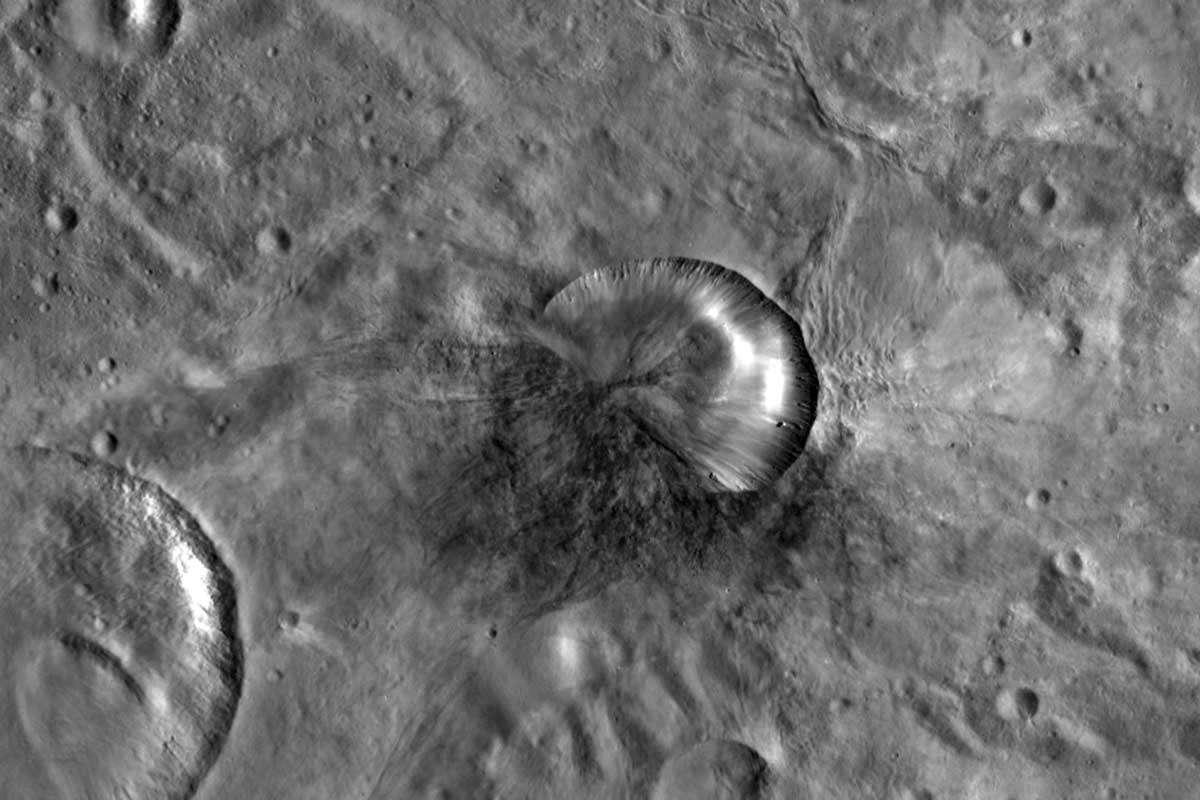
Researchers believe they’ve found the origin of meteorite fragments that fell near the Turkish village of Sariçiçek in 2015. An international team of scientists, including SETI Institute Senior Research Scientist Peter Jenniskens, revealed the fragments came from a 22-million-year-old impact crater on the asteroid Vesta. New Scientist picked up the story:
Both the size of the Antonia impact crater and the age of the material around it suggest it is the likely origin for the Sariçiçek meteorite, says Jenniskens…The meteorite was the first of a type called howardite to ever impact Earth. Howardite belongs to a group classified as howardite-eucrite-dogenites (HED), which astrophysicists have long suspected originated from Vesta or asteroids associated with it.
“About one-third of all HED meteorites are 22 million years old,” says Jenniskens. “What it says is that this particular rock came from a big collision event, so we were looking for a big crater.”
In a SETI Institute press release, Jenniskens described the strategy researchers employed to determine the meteorite’s origin:
“We used video security camera footage in nearby cities to determine the meteor’s trajectory and orbit,” says Peter Jenniskens, a SETI Institute researcher at NASA Ames Research Center, who participated in the field study to investigate the meteorite’s origins. “The orbit provided the first dynamical link between the normal HED meteorite clan and the inner main belt where Vesta is located.”
The research was presented in a study published in the journal Meteoritics & Planetary Science.
- New Scientist: NASA traced a meteorite back to its original home in deep space
- Meteoritics & Planetary Science: The Sariçiçek howardite fall in Turkey: Source crater of HED meteorites on Vesta and impact risk of Vestoids
- SETI.org: Turkish Meteorite Traced to Impact Crater on Asteroid Vesta
 UAB Senior Describes Internship at SETI Institute: “I’m interested in finding life on other planets”
UAB Senior Describes Internship at SETI Institute: “I’m interested in finding life on other planets”Jakayla Robinson is a senior at University of Alabama at Birmingham’ College of Arts and Sciences, majoring in physics. Last summer she came to the SETI Institute to intern with Senior Research Scientist Matthew Tiscareno. UAB’s The Mix profiled her experience studying the rings of Saturn with Tiscareno:
Since last summer, Robinson has been working with mentor Matthew Tiscareno, Ph.D., a senior research scientist at the Search for Extraterrestrial Intelligence (SETI) Institute in Mountain View, California, to study odd features in Saturn’s rings known as propellers, which Tiscareno first reported in 2006… Last year Robinson, who had recently switched to a physics major, contacted Tiscareno to see if he had any places in his lab and ended up with a summer position. “I didn’t have any background in physics until I got to UAB,” Robinson said. “But the more I learn, the more I feel like physics explains life itself. The whole reason I went to SETI is because I’m interested in finding life on other planets.”
Robinson described her time with SETI Institute over the summer, and spending time with other students as well as participants in the SETI Institute Astrobiology Research Experience for Undergraduates (REU) program:
She and a number of other undergraduates stayed in a NASA-owned lodge in Mountain View (SETI Institute is a major NASA contractor) and had their own workstations in the Tiscareno lab. “It wasn’t the typical 9-to–5” workday, Robinson said. “Every student had building access and we could work whenever we wanted to, when we were most productive. Matt is a great mentor.”
- UAB The Mix: Student explores mysterious shapes in Saturn’s rings
- SETI.org: General Information about the SETI Institute Astrobiology REU Program
In last week’s episode, meet the creatures that dominated the globe for nearly 165 million years - and dominated screens in the Jurassic Park franchise. Find out why the golden age of dinosaur discovery has just begun, in an encore of Free Range Dinosaurs. Our previous week’s episode explored the elusive property of liquids, from Earth’s molten core to your bloodstream, in Go with the Flow.
Last time on Facebook Live, SETI Institute's Franck Marchis spoke with Ariel Waldman about her field expedition to Antarctica. Videos of all past Facebook Live events can be found on our Facebook page: https://www.facebook.com/SETIInstitute/
- Golden Gate Bridging: April 27, 2019, San Francisco, CA SETI Institute Director of Education Pamela Harman will be previewing the new Cadette Space Science Researcher badge at Chrissy Field.
- 2019 Drake Awards: May 8, 2019, Menlo Park, CA Special guests include Frank Drake, Jill Tarter, Ed Lu, Bill Borucki, Seth Shostak, and Drake Award recipient Jason Wright.
- Silicon Valley Astronomy Lecture Series: May 15, 2019 Los Altos, CA SETI Institute scientist Ross Beyer will present, Charon, Pluto’s Companion: What We’re Learning from New Horizons
- AI for Good Global Summit: May 28-13, 2019, Geneva, Switzerland Bill Diamond, President and CEO of the SETI Institute, and James Parr, Director of Frontier Development Lab (FDL) will be participating in sessions exploring AI and space
- AbSciCon: June 24-28, 2019, Bellevue WA The SETI Institute will be a participating sponsor





